Simultaneous Cryogenic Radical and Oxidative Coupling Polymerizations to Polyaniline/Polyacrylamide Conductive Cryogels for Gas Sensing
Abstract
:1. Introduction
2. Results and Discussion
2.1. Simultaneous Polymerizations of AAm and ANI under Cryogenic Condition
2.2. Structural Analysis and Gas Adsorption of 1/5-PA-PANI/PAAm Cryogels
2.3. Dependence of Cryogel Conductivity on the Adsorbed Amount of HCl and NH3
2.4. Sensing Performance of PA-PANI/PAAm Cryogel to HCl and NH3
3. Conclusions
4. Experimental
4.1. Materials
4.2. Investigation of Simultaneous Polymerization of Aniline and Acrylamide
4.2.1. Structural Change of Aniline Protonated with Different Acids
4.2.2. Study of Simultaneous Cryo-Polymerizations in the Presence of Different Acids
4.3. Synthesis of PANI/PAAm Cryogels through Simultaneous Cryo-Polymerizations
4.4. Fabrication of Gas Sensor
4.5. Characterizations and Intruments
4.6. Study of the Sensing Performance to Different Gases
Supplementary Materials
Author Contributions
Funding
Institutional Review Board Statement
Informed Consent Statement
Data Availability Statement
Acknowledgments
Conflicts of Interest
References
- Jin, Y.J.; Park, J. QCM-Based HCl gas sensors using spin-coated aminated polystyrene colloids. Polymers 2020, 12, 1591. [Google Scholar] [CrossRef]
- Orzel, R.A. Toxicological aspects of firesmoke: Polymer pyrolysis and combustion. Occup. Med.—State Art Rev. 1993, 8, 414–429. [Google Scholar]
- Joshi, A.; Gangal, S.A.; Gupta, S.K. Ammonia sensing properties of polypyrrole thin films at room temperature. Sens. Actuat. B Chem. 2011, 156, 938–942. [Google Scholar] [CrossRef]
- Wang, H.; Lustig, W.P.; Li, J. Sensing and capture of toxic and hazardous gases and vapors by metal-organic frameworks. Chem. Soc. Rev. 2018, 47, 4729–4756. [Google Scholar] [CrossRef] [PubMed]
- Dey, A. Semiconductor metal oxide gas sensors: A review. Mater. Sci. Eng. B 2018, 229, 206–217. [Google Scholar] [CrossRef]
- Huang, B.; Li, Z.Y.; Liu, Z.R.; Zhou, G.; Hao, S.G.; Wu, J.; Gu, B.L.; Duan, W.H. Adsorption of gas molecules on graphene nanoribbons and its implication for nanoscale molecule sensor. J. Phys. Chem. C 2008, 112, 13442–13446. [Google Scholar] [CrossRef]
- Swager, T.M. 50th Anniversary perspective: Conducting/semiconducting conjugated polymers. A personal perspective on the past and the future. Macromolecules 2017, 50, 4867–4886. [Google Scholar] [CrossRef]
- Chen, X.; Li, D.M.; Liang, S.F.; Zhan, S.; Liu, M. Gas sensing properties of surface acoustic wave NH3 gas sensor based on Pt doped polypyrrole sensitive film. Sens. Actuat. B Chem. 2013, 177, 364–369. [Google Scholar] [CrossRef]
- Su, P.G.; Peng, Y.T. Fabrication of a room-temperature H2S gas sensor based on PPy/WO3 nanocomposite films by in-situ photopolymerization. Sens. Actuat. B Chem. 2014, 193, 637–643. [Google Scholar] [CrossRef]
- Meng, F.L.; Guo, Z.; Huang, X.J. Graphene-based hybrids for chemiresistive gas sensors. TRAC Trend. Ana. Chem. 2015, 68, 37–47. [Google Scholar] [CrossRef]
- Dong, L.; Chen, Z.; Zhao, X.; Ma, J.; Lin, S.; Li, M.; Bao, Y.; Chu, L.; Leng, K.; Lu, H.; et al. A non-dispersion strategy for large-scale production of ultra-high concentration graphene slurries in water. Nat. Commun. 2018, 9, 76. [Google Scholar] [CrossRef] [Green Version]
- Zhang, J.; Liu, X.; Neri, G.; Pinna, N. Nanostructured materials for room-temperature gas sensors. Adv. Mater. 2016, 28, 795–831. [Google Scholar] [CrossRef] [PubMed]
- Chen, J.; Yang, J.; Yan, X.; Xue, Q. NH3 and HCl sensing characteristics of polyaniline nanofibers deposited on commercial ceramic substrates using interfacial polymerization. Synth. Met. 2010, 160, 2452–2458. [Google Scholar] [CrossRef]
- Albaris, H.; Karuppasamy, G. Investigation of NH3 gas sensing behavior of intercalated PPy–GO–WO3 hybrid nanocomposite at room temperature. Mater. Sci. Eng. B 2020, 257, 114558. [Google Scholar] [CrossRef]
- Armitage, B.I.; Murugappan, K.; Lefferts, M.J.; Cowsik, A.; Castell, M.R. Conducting polymer percolation gas sensor on a flexible substrate. J. Mate Chem. C 2020, 8, 12669–12676. [Google Scholar] [CrossRef]
- Xiang, C.; Jiang, D.; Zou, Y.; Chu, H.; Qiu, S.; Zhang, H.; Xu, F.; Sun, L.; Zheng, L. Ammonia sensor based on polypyrrole–graphene nanocomposite decorated with titania nanoparticles. Ceram. Int. 2015, 41, 6432–6438. [Google Scholar] [CrossRef]
- Lv, Y.Y.; Wu, J.; Xu, Z.K. Colorimetric and fluorescent sensor constructing from the nanofibrous membrane of porphyrinated polyimide for the detection of hydrogen chloride gas. Sens. Actuat. B Chem. 2010, 148, 233–239. [Google Scholar] [CrossRef]
- Uluturk, C.; Alemdar, N. Electroconductive 3D polymeric network production by using polyaniline/chitosan-based hydrogel. Carbohydr. Polym. 2018, 193, 307–315. [Google Scholar] [CrossRef]
- Deng, Z.; Guo, Y.; Ma, P.X.; Guo, B. Rapid thermal responsive conductive hybrid cryogels with shape memory properties, photothermal properties and pressure dependent conductivity. J. Colloid. Interface Sci. 2018, 526, 281–294. [Google Scholar] [CrossRef]
- Pyarasani, R.D.; Jayaramudu, T.; John, A. Polyaniline-based conducting hydrogels. J. Mater. Sci. 2018, 5, 974–996. [Google Scholar] [CrossRef]
- Wang, D.W.; Li, F.; Zhao, J.; Ren, W.; Chen, Z.G.; Tan, J.; Wu, Z.S.; Gentle, I.; Lu, G.Q.; Cheng, H.M. Fabrication of graphene/polyaniline composite paper via in situ anodic electropolymerization for high-performance flexible electrode. ACS Nano 2009, 3, 1745–1752. [Google Scholar] [CrossRef] [PubMed]
- Li, W.W.; Gao, F.X.; Wang, X.Q.; Zhang, N.; Ma, M.M. Strong and robust polyaniline-based supramolecular hydrogels for flexible supercapacitors. Angew. Chem. Int. Ed. 2016, 55, 9196–9201. [Google Scholar] [CrossRef] [PubMed]
- Lu, X.X.; Li, P.Y.; Li, J.M.; He, W.D. Preparation and investigation of conductive hydrogels of polyacrylamide-g-polyaniline. Acta Polym. Sin. 2016, 11, 1563–1571. [Google Scholar]
- Wang, J.Y.; Guo, X.X.; Chen, J.; Hou, S.C.; Li, H.J.; Haleem, A.; Chen, S.Q.; He, W.D. A versatile platform of poly(acrylic acid) cryogel for highly efficient photothermal water evaporation. Mate Adv. 2021, 2, 3088–3098. [Google Scholar] [CrossRef]
- Haleem, A.; Li, H.J.; Li, P.Y.; Hu, C.S.; Li, X.C.; Wang, J.Y.; Chen, S.Q.; He, W.D. Rapid UV-radiation synthesis of polyacrylate cryogel oil-sorbents with adaptable structure and performance. Env. Res. 2020, 187, 109488. [Google Scholar] [CrossRef] [PubMed]
- Hu, C.S.; Li, H.J.; Wang, J.Y.; Haleem, A.; Li, X.C.; Siddiq, M.; He, W.D. Mushroom-like rGO/PAM hybrid cryogels with efficient solar-heating water evaporation. ACS Appl. Energy Mater. 2019, 2, 7554–7563. [Google Scholar]
- Dragan, E.S.; Perju, M.M.; Dinu, M.V. Preparation and characterization of IPN composite hydrogels based on polyacrylamide and chitosan and their interaction with ionic dyes. Carbohyd. Polym. 2012, 88, 270–281. [Google Scholar] [CrossRef]
- Chen, X.; Sui, W.; Ren, D.; Ding, Y.; Zhu, X.; Chen, Z. Synthesis of hydrophobic polymeric cryogels with supermacroporous structure. Macromol. Mater. Eng. 2016, 301, 659–664. [Google Scholar] [CrossRef]
- Eisazadeh, H.; Kavian, A. Copolymerization of aniline and styrene using various surfactants in aqueous media. Polym. Compos. 2009, 30, 43–48. [Google Scholar] [CrossRef]
- Shi, Y.; Ma, C.; Peng, L.J.; Yu, G.H. Conductive “smart” hybrid hydrogels with PNIPAM and nanostructured conductive polymers. Adv. Funct. Mater. 2015, 25, 1219–1225. [Google Scholar] [CrossRef]
- Zhao, F.; Shi, Y.; Pan, L.J.; Yu, G.H. Multifunctional nanostructured conductive polymer gels: Synthesis, properties, and applications. Acc. Chem. Res. 2017, 50, 1734–1743. [Google Scholar] [CrossRef] [PubMed]
- Lozinsky, V.I.; Okay, O. Basic principles of cryotropic gelation. Adv. Polym. Sci. 2014, 263, 49–102. [Google Scholar]
- Quillard, S.; Louarn, G.; Lefrant, S.; Macdiarmid, A.G. Vibrational analysis of polyaniline: A comparative study of leucoemeraldine, emeraldine, and pernigraniline bases. Phy. Rew. B 1994, 50, 12496–12508. [Google Scholar] [CrossRef] [PubMed]
- Kang, E.T.; Neoh, K.G.; Tan, K.L. Polyaniline: A Polymer with many interesting intrinsic redox states. Prog. Polym. Sci. 1998, 23, 211–324. [Google Scholar] [CrossRef]
- Hu, H.; Saniger, J.M.; Bañuelos, J.G. Thin films of polyaniline–polyacrylic acid composite by chemical bath deposition. Thin. Solid. Film. 1999, 347, 241–247. [Google Scholar] [CrossRef]
- Athawale, A.A.; Kulkarni, M.V.; Chabukswar, V.V. Studies on chemically synthesized soluble acrylic acid doped polyaniline. Mater. Chem. Phys. 2002, 73, 106–110. [Google Scholar] [CrossRef]
- Ryu, K.S.; Moon, B.W.; Joo, J.; Chang, S.H. Characterization of highly conducting lithium salt doped polyaniline films prepared from polymer solution. Polymer 2001, 42, 9355–9360. [Google Scholar] [CrossRef]
- Syed, A.A.; Dinesan, M.K. Review: Polyaniline-A novel polymeric material. Talanta 1991, 38, 815–837. [Google Scholar] [CrossRef]
- Stejskal, J.; Gilbert, R.G. Polyaniline. Preparation of a conducting polymer (IUPAC technical report). Pure Appl. Chem. 2002, 74, 857–867. [Google Scholar] [CrossRef]
- Wang, X.F.; Wang, J.L.; Si, Y.; Ding, B.; Yu, J.Y.; Sun, G.; Luo, W.J.; Zhang, G. Nanofiber-net-binary structured membranes for highly sensitive detection of trace HCl gas. Nanoscale 2012, 4, 7585–7592. [Google Scholar] [CrossRef]
- Kukla, A.L.; Shirshov, Y.M.; Piletsky, S.A. Ammonia sensors based on sensitive polyaniline films. Sens. Actuat. B Chem. 1996, 37, 135–140. [Google Scholar] [CrossRef]
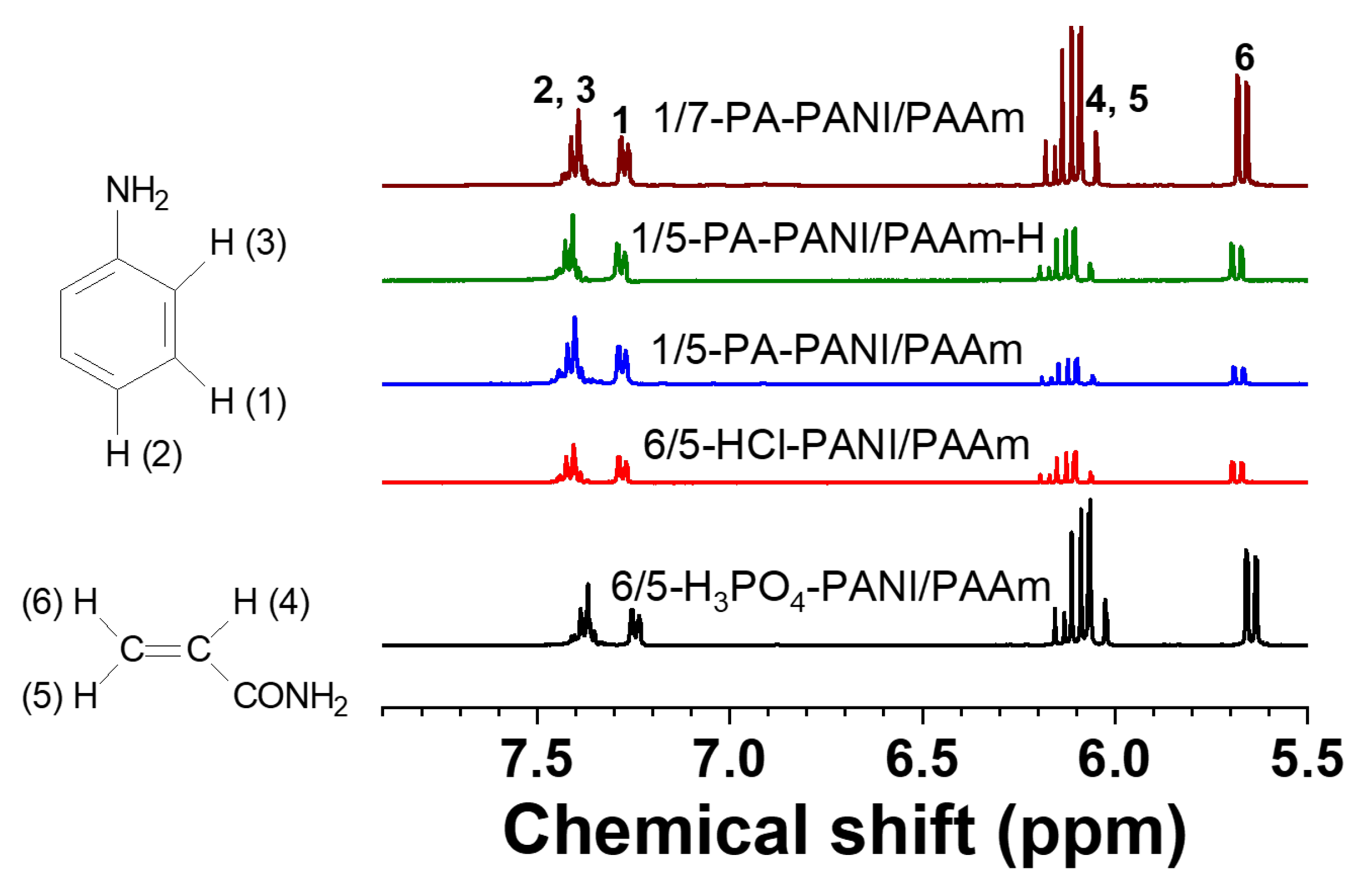
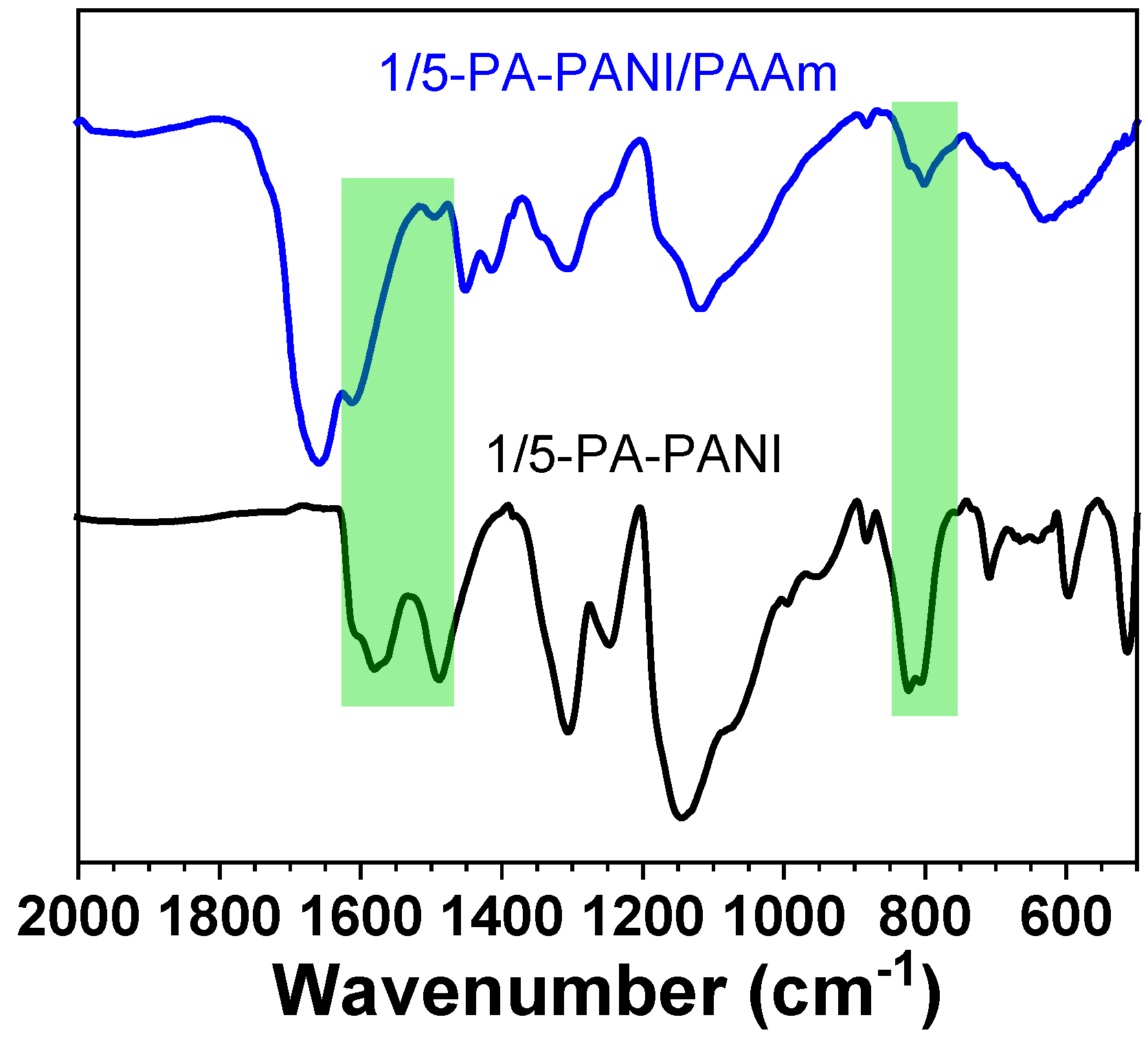
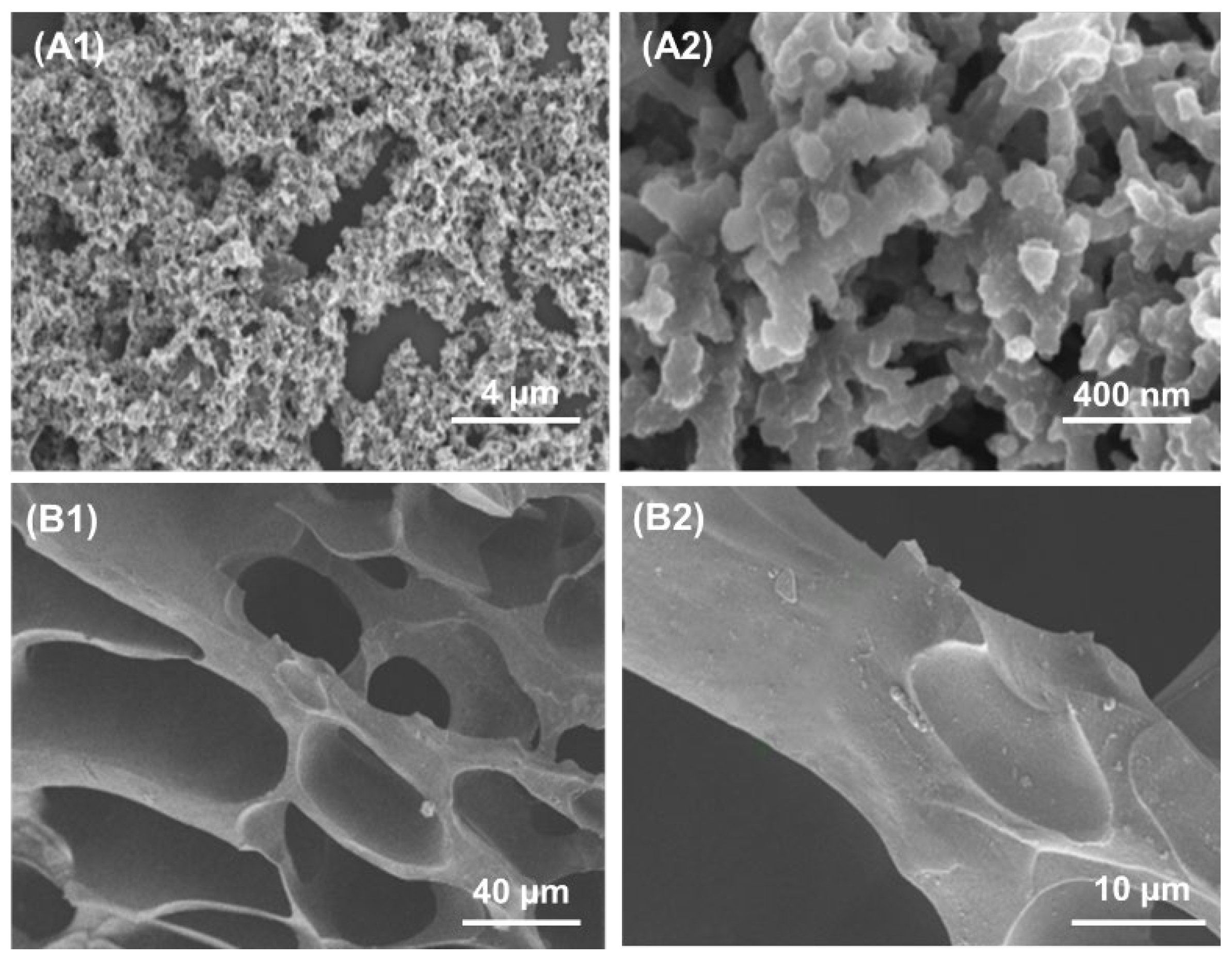
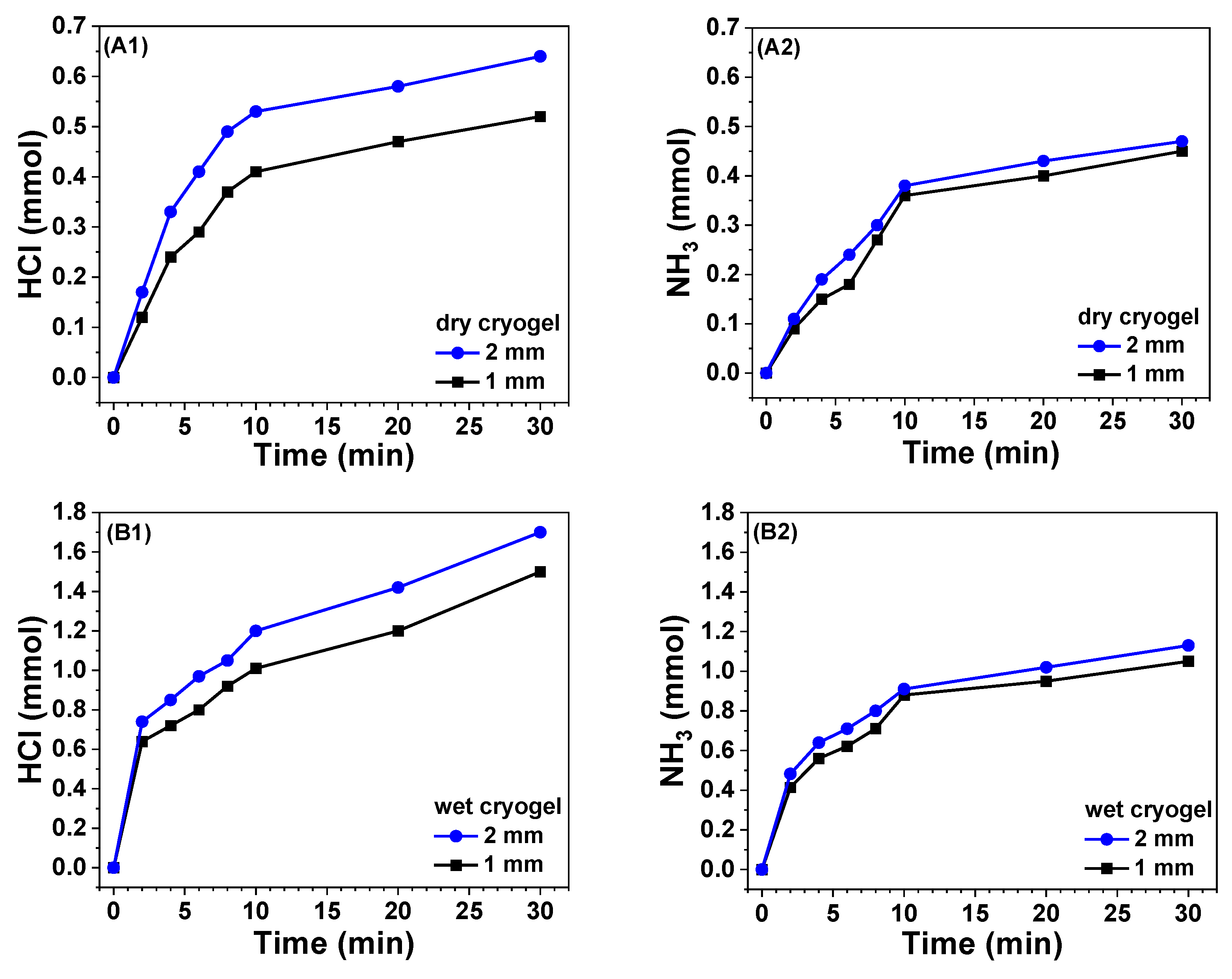
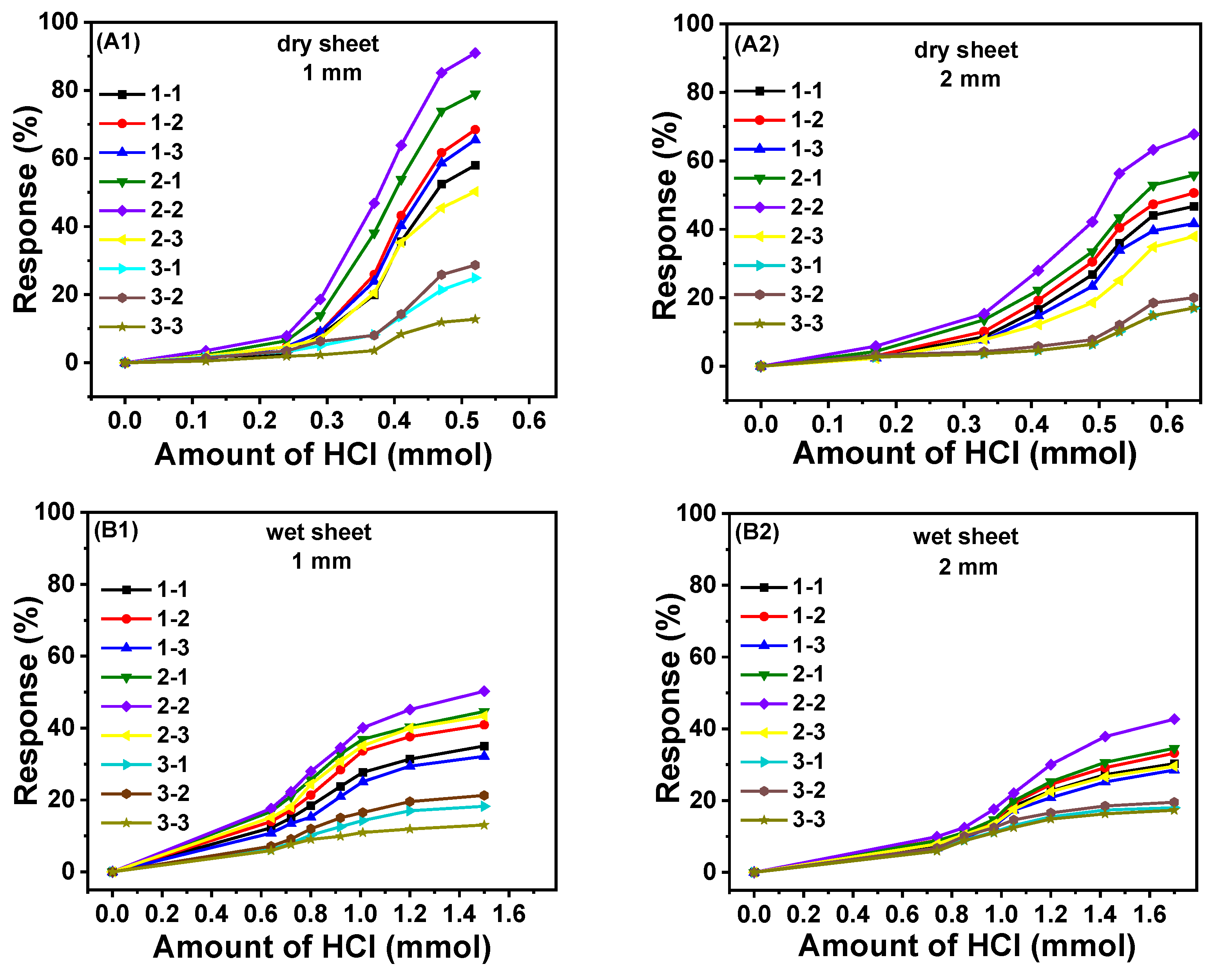
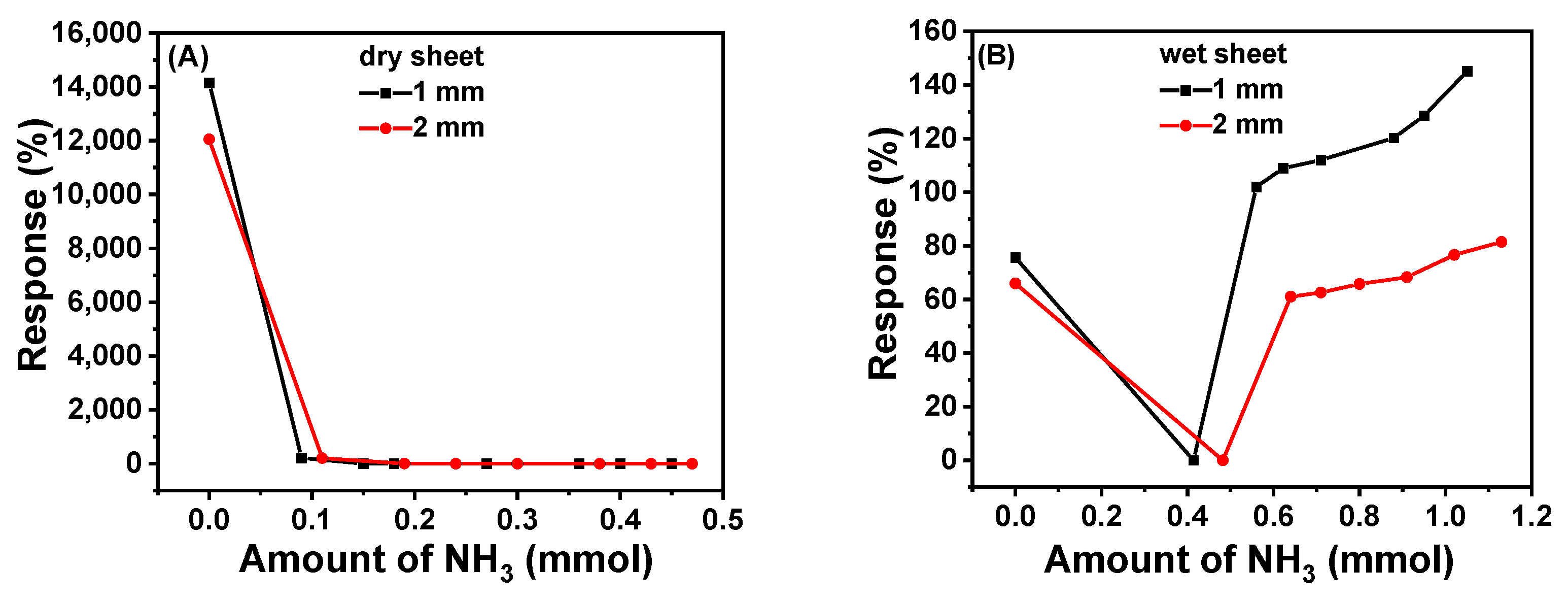
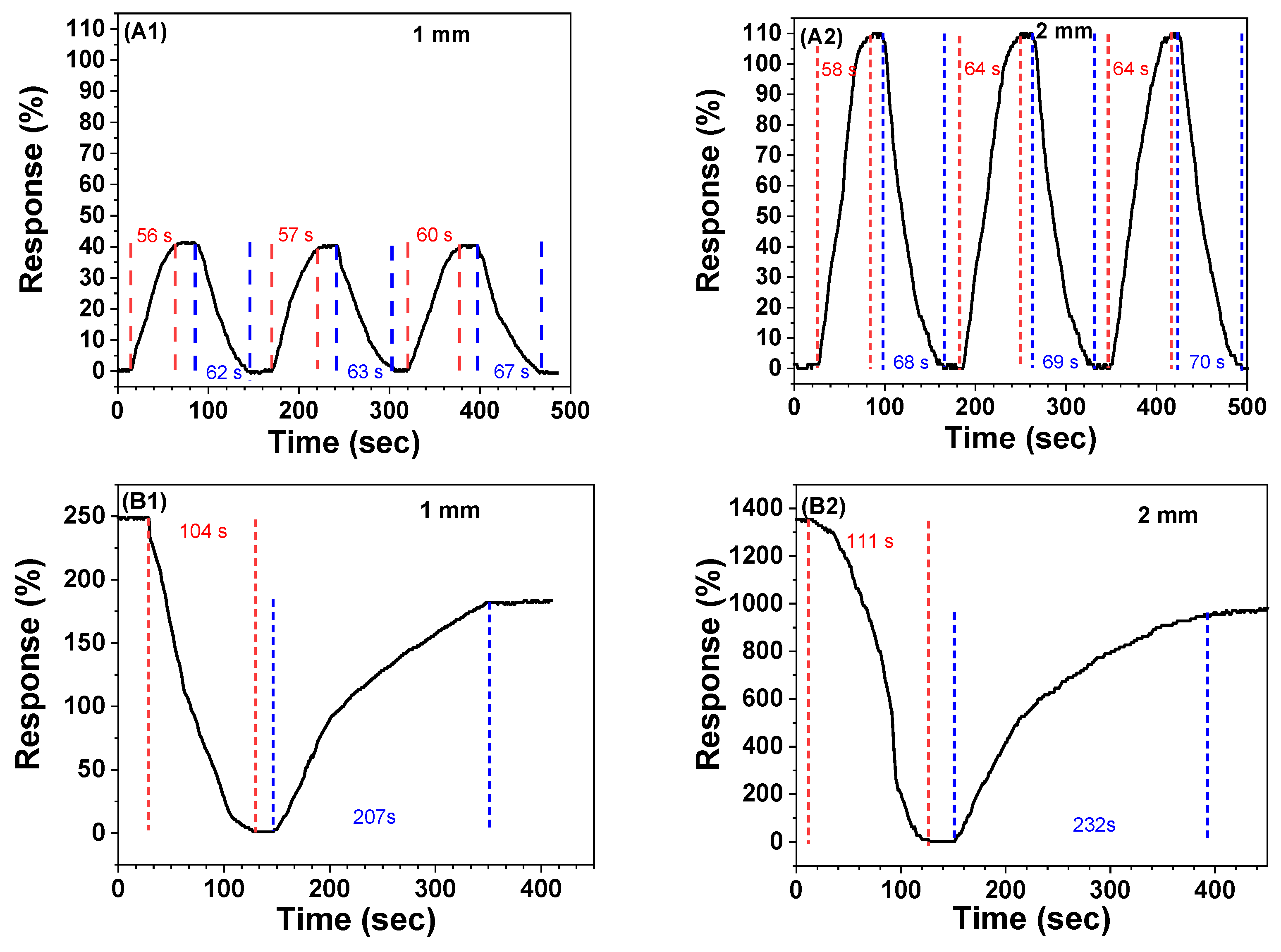
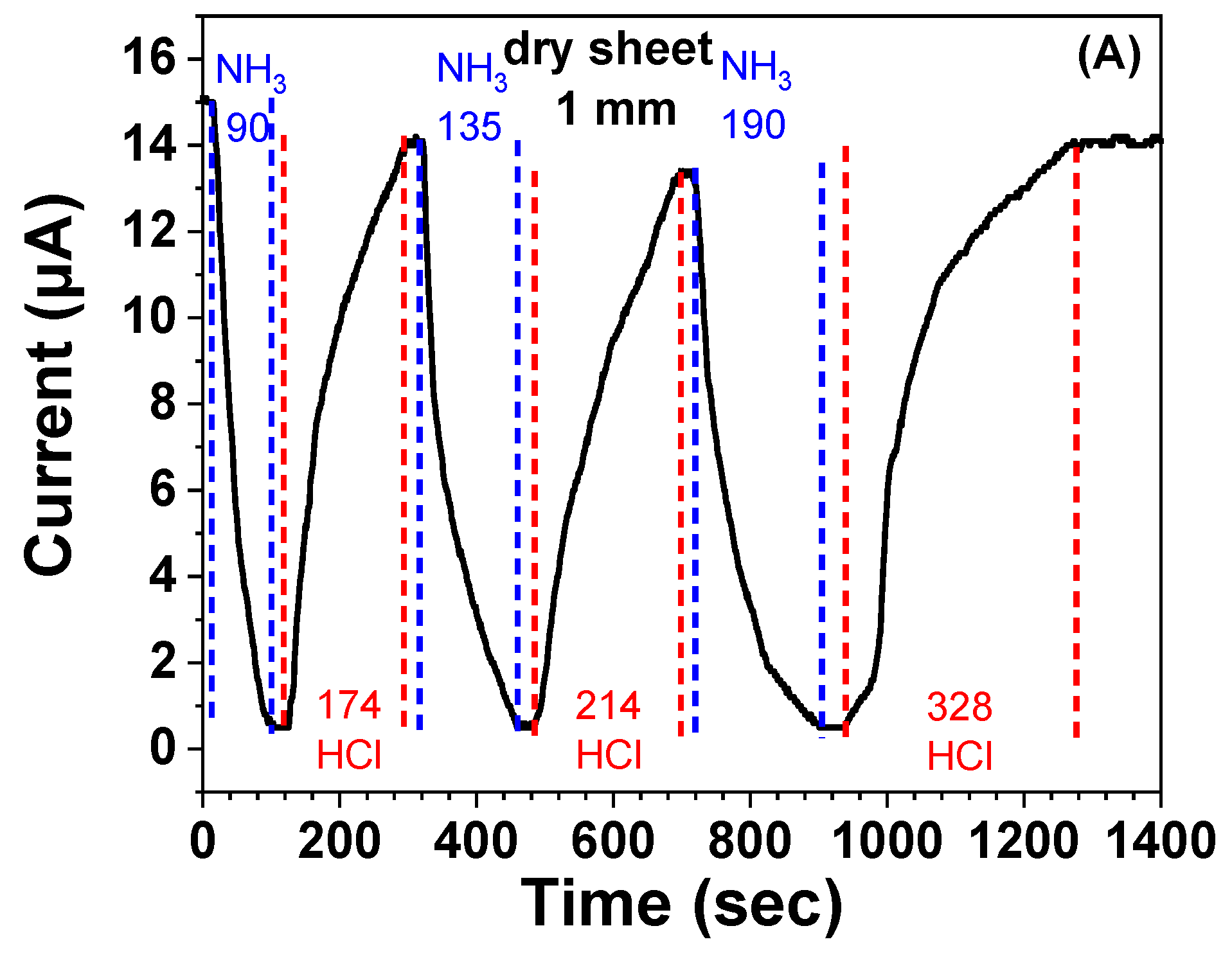
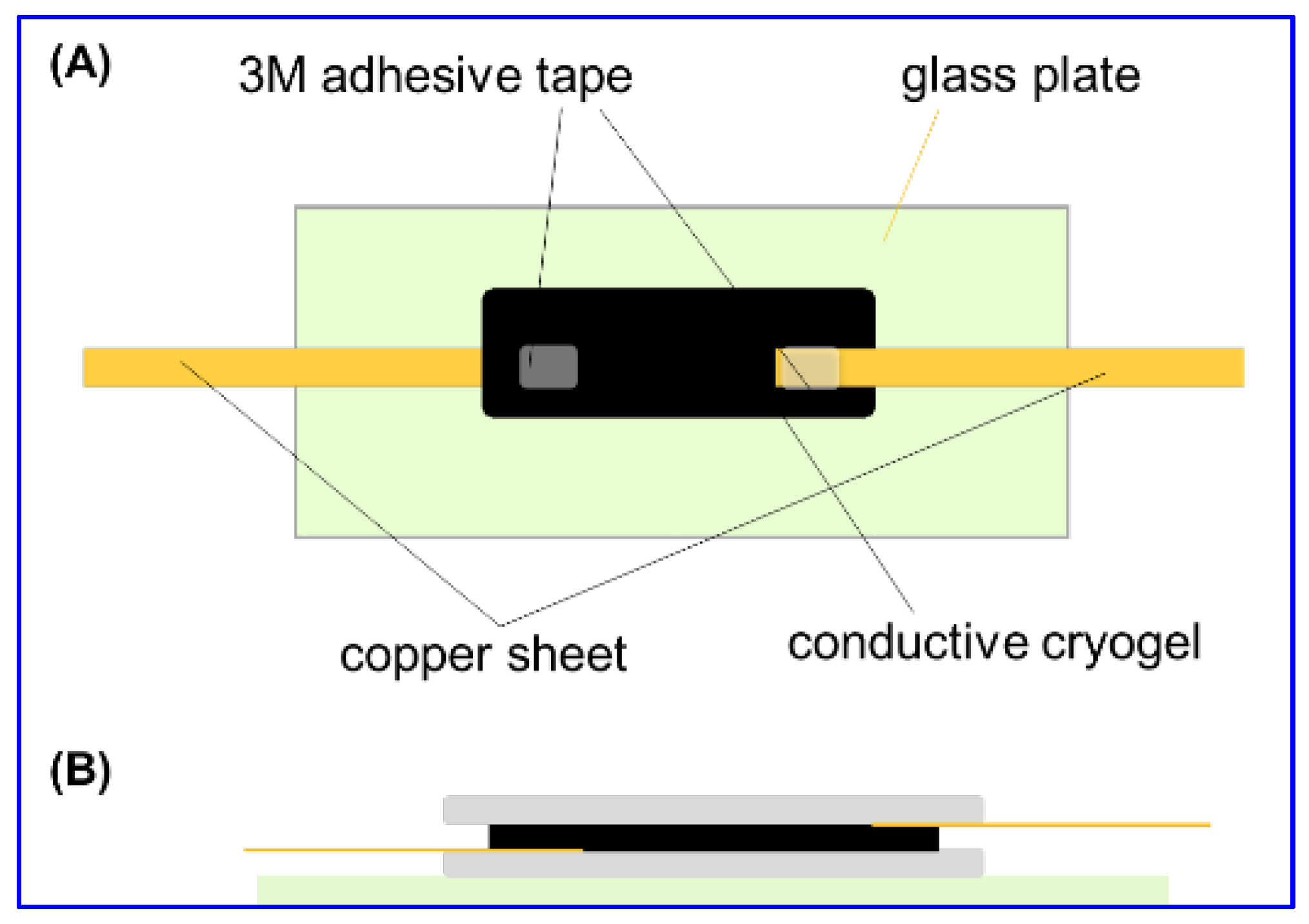
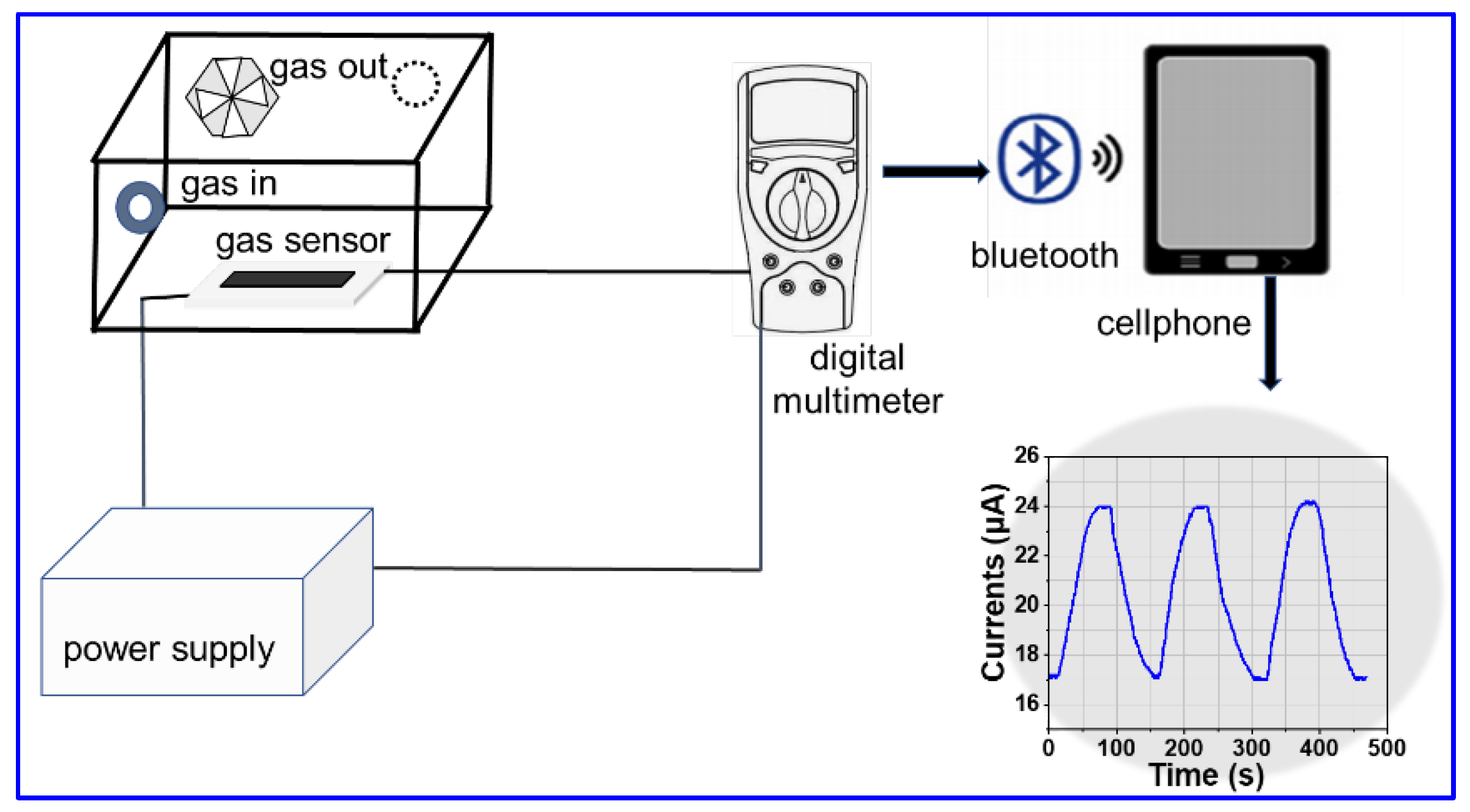
| Mixture | Temperature (°C) | Acid | Acid: ANI in Mole | Gel |
|---|---|---|---|---|
| 1/7-PA-ANI-AAm | −25 | PA | 1:7 | 1/7-PA-PANI/PAAm |
| 1/5-PA-ANI-AAm-H | 10 | PA | 1:5 | 1/5-PA-PANI/PAAm-H |
| 1/5-PA-ANI-AAm | −25 | PA | 1:5 | 1/5-PA-PANI/PAAm |
| 6/5-HCl-ANI-AAm | −25 | HCl | 6:5 | 6/5-HCl-PANI/PAAm |
| 6/5-H3PO4-ANI-AAm | −25 | H3PO4 | 6:5 | 6/5-H3PO4-PANI/PAAm |
| Gel | AAm | ANI | ||
|---|---|---|---|---|
| Surplus | Conversion | Surplus | Conversion | |
| 1/7-PA-PANI/PAAm | 103.3 mg | 75.8% | 3.9 | 98.3% |
| 1/5-PA-PANI/PAAm-H | 16.4 mg | 96.2% | 3.9 | 98.3% |
| 1/5-PA-PANI/PAAm | 12.5 mg | 97.1% | 3.3 | 98.6% |
| 6/5-HCl-PANI/PAAm | 14.1 mg | 96.7% | 3.6 | 98.5% |
| 6/5-H3PO4-PANI/PAAm | 109.5 mg | 74.3% | 3.7 | 98.4% |
| Cryogel | Molar Ratio | Charged Amount | |||
|---|---|---|---|---|---|
| PA:ANI | ANI:AAm | ANI | PA | APS | |
| 1-1 | 1:5 | 1:2.4 | 2.5 mmol | 0.50 mmol | 0.63 mmol |
| 1-2 | 1:2 | 3.0 mmol | 0.60 mmol | 0.76 mmol | |
| 1-3 | 2:3 | 4.0 mmol | 0.80 mmol | 1.000 mol | |
| 2-1 | 1:4 | 1:2.4 | 2.5 mmol | 0.63 mmol | 0.63 mmol |
| 2-2 | 1:2 | 3.0 mmol | 0.75 mmol | 0.76 mmol | |
| 2-3 | 2:3 | 4.0 mmol | 1.00 mmol | 1.00 mmol | |
| 3-1 | 1:3 | 1:2.4 | 2.5 mmol | 0.83 mmol | 0.63 mmol |
| 3-2 | 1:2 | 3.0 mmol | 1.00 mmol | 0.76 mmol | |
| 3-3 | 2:3 | 4.0 mmol | 1.33 mmol | 1.00 mmol | |
Publisher’s Note: MDPI stays neutral with regard to jurisdictional claims in published maps and institutional affiliations. |
© 2022 by the authors. Licensee MDPI, Basel, Switzerland. This article is an open access article distributed under the terms and conditions of the Creative Commons Attribution (CC BY) license (https://creativecommons.org/licenses/by/4.0/).
Share and Cite
Guo, X.-X.; Hou, S.-C.; Li, H.-J.; Chen, J.; Haleem, A.; He, W.-D. Simultaneous Cryogenic Radical and Oxidative Coupling Polymerizations to Polyaniline/Polyacrylamide Conductive Cryogels for Gas Sensing. Gels 2022, 8, 556. https://doi.org/10.3390/gels8090556
Guo X-X, Hou S-C, Li H-J, Chen J, Haleem A, He W-D. Simultaneous Cryogenic Radical and Oxidative Coupling Polymerizations to Polyaniline/Polyacrylamide Conductive Cryogels for Gas Sensing. Gels. 2022; 8(9):556. https://doi.org/10.3390/gels8090556
Chicago/Turabian StyleGuo, Xiao-Xiao, Shi-Chang Hou, Hui-Juan Li, Jun Chen, Abdul Haleem, and Wei-Dong He. 2022. "Simultaneous Cryogenic Radical and Oxidative Coupling Polymerizations to Polyaniline/Polyacrylamide Conductive Cryogels for Gas Sensing" Gels 8, no. 9: 556. https://doi.org/10.3390/gels8090556






